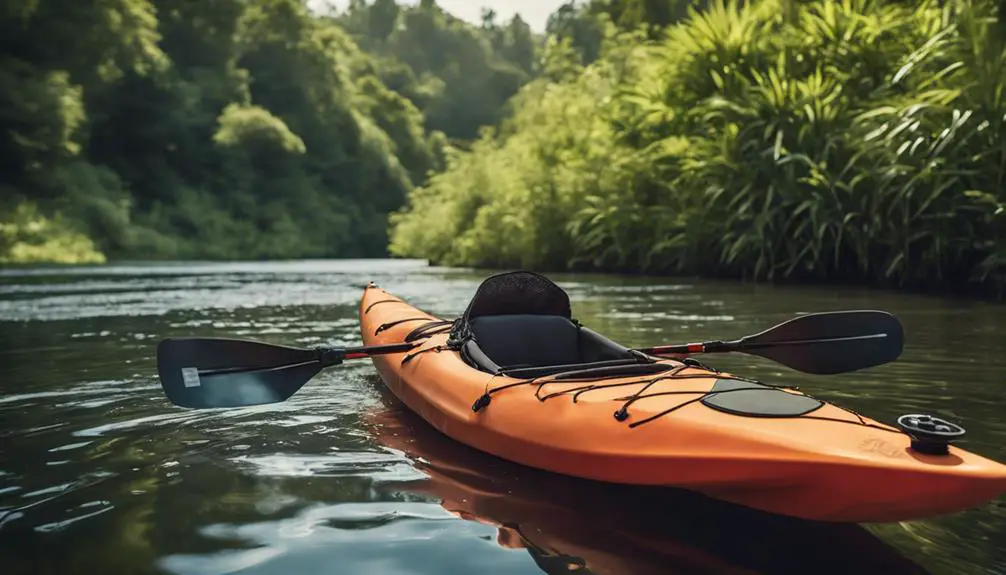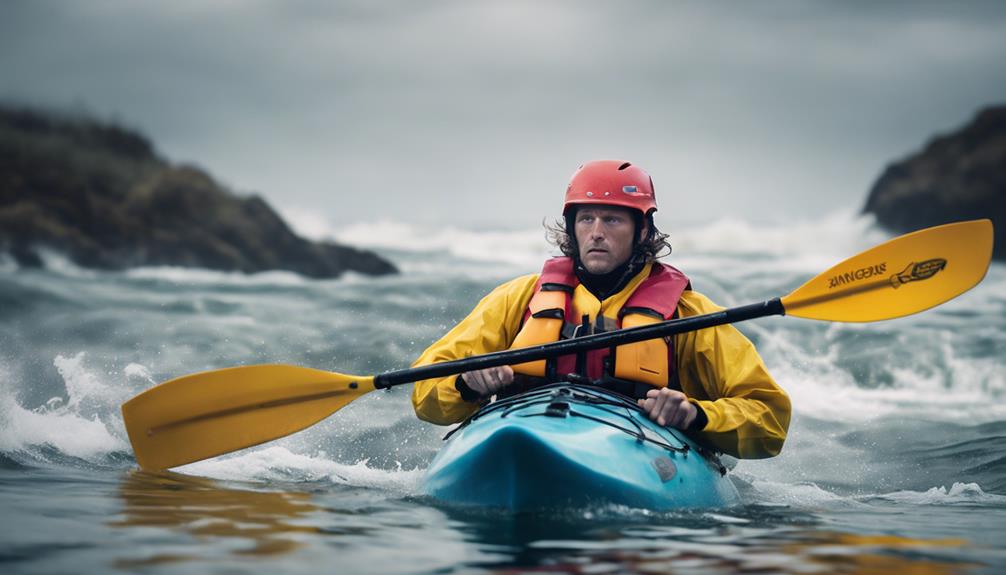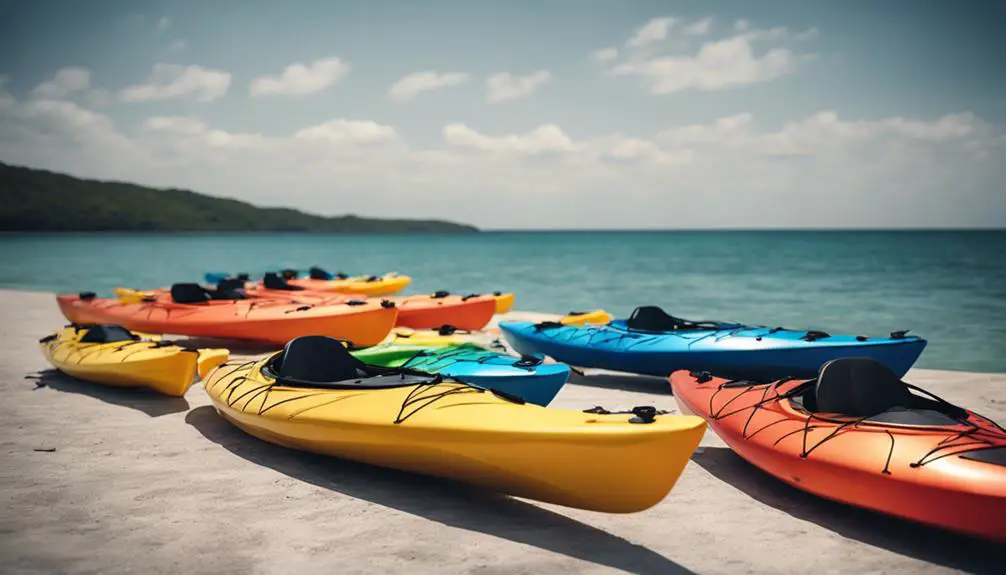
Staying safe while you're out kayaking is a top priority, and there are five key pieces of gear you shouldn't go without. Let's start with personal flotation devices (PFDs). For calm waters, a Type III PFD is ideal, while rougher conditions call for a Type V. These are crucial for your safety on the water.
Next up, helmets are essential for protecting your head from any impacts. Look for one that fits snugly and has adjustable features to ensure a comfortable and secure fit. Your safety gear isn't complete without a reliable helmet.
In case of emergencies, a first aid kit is a must-have. Keep basic supplies and tools in a waterproof container to ensure they stay dry and accessible when needed. It's always better to be prepared for the unexpected.
Don't forget about bilge pumps. These are vital for removing water from your kayak, especially in case of water intake. Make sure to choose one that suits the size of your vessel and remember to maintain it regularly for optimal performance.
Lastly, signal devices like whistles and reflective mirrors are crucial for visibility and alerting others in the vicinity. Waterproof whistles and reflective mirrors can make a real difference in getting help when it's needed. Stay visible and stay safe out on the water.
Personal Flotation Devices
Personal flotation devices (PFDs) are a must-have when kayaking. They keep you afloat in the water, which is crucial for your safety. Getting the right fit is key; your PFD should feel snug but not tight, allowing you to move freely without it riding up.
There are different types of PFDs designed for various kayaking activities. For casual paddling, Type III PFDs are popular as they are comfortable and offer easy movement. If you're tackling rough waters, Type V PFDs provide extra buoyancy and safety features.
When choosing a PFD, consider factors like buoyancy, comfort, and how you plan to use it. By picking the right one and ensuring it fits well, you can have a worry-free kayaking experience.
Helmets
Wearing a helmet while kayaking is super important to protect your head from potential impacts with rocks, branches, or other obstacles you might run into on the water. When picking out a helmet, there are a few things to keep in mind to make sure you stay safe and comfortable.
First off, make sure the helmet fits just right – snug but not too tight. Helmets made of durable ABS plastic or carbon fiber offer solid protection. You can choose from different styles like full-cut, half-cut, or face-guard based on what suits your kayaking style and personal preference.
Brands like Sweet Protection, WRSI, and NRS offer reliable options with different features to consider. Don't forget to check for helmets with adjustable straps and padding so you can customize the fit for maximum security and comfort.
First Aid Kits
Having a well-stocked first aid kit on your kayak is crucial for handling injuries effectively and ensuring prompt medical attention while out on the water. This kit should contain basic supplies for wilderness medicine like bandages, antiseptic wipes, and adhesive tape to treat wounds.
It's also helpful to have tools such as tweezers and scissors for addressing minor injuries. Consider getting first aid training to be prepared for emergencies, allowing you to respond effectively in critical situations.
To keep your supplies dry and usable, carry them in a waterproof container. By focusing on these essentials, kayakers can explore remote areas with confidence, knowing they are ready for unexpected medical incidents. This proactive approach promotes personal safety and enhances the overall kayaking adventure.
Bilge Pumps
A bilge pump is like a trusty sidekick for kayakers, helping them stay afloat by quickly getting rid of any unwanted water in the vessel. To keep it in top-notch condition, it's essential to give it the care it deserves.
Understanding the different types of bilge pumps available can guide you in making the right choice. Here are a few things to keep in mind:
First off, there are two main types to consider: manual and electric. Manual pumps are great for their portability and independence from power sources, while electric pumps offer convenience but rely on batteries to do the job.
When picking a pump, make sure to match its capacity with your vessel's size and the conditions you typically encounter. You wouldn't want to be stuck with a pump that can't keep up when things get a little too wet.
Ease of use is also key. Look for pumps with ergonomic designs that make operating them a breeze. After all, you want to focus on paddling, not struggling with your pump.
Lastly, don't forget about maintenance. Regularly check and clean your pump to ensure it's always ready to spring into action when you need it the most. A little TLC can go a long way in keeping your pump performing at its best.
Whistles and Signal Devices
Whistles and signal devices are like your emergency hotline on the water. They're must-have tools for kayakers to stay visible and audible, especially in times of need. Imagine a whistle as your lifeline; a sharp blast can instantly alert nearby paddlers or rescue teams to your situation.
To ensure reliability, opt for a waterproof, pea-less whistle that won't fail you even when wet. Additionally, signaling devices like reflective mirrors or strobe lights play a crucial role in enhancing your visibility, allowing rescuers to spot you quickly in case of an emergency.
Frequently Asked Questions
What Type of Footwear Is Best for Kayaking?
When deciding on the best footwear for kayaking, you have a few options to consider. Water shoes or neoprene booties are great choices for providing protection and comfort while out on the water. They offer grip and insulation to keep your feet safe and warm during your kayaking adventure.
If you prefer a more relaxed feel and enjoy the freedom of movement, slip-on sandals or going barefoot can be suitable alternatives. These options allow for a more natural and unrestricted paddling experience, letting you feel connected to the water beneath you.
Ultimately, the best footwear for kayaking depends on your personal preference and comfort level. Whether you opt for water shoes, neoprene booties, slip-on sandals, or barefoot paddling, make sure to choose footwear that allows you to enjoy your time on the water to the fullest.
Are Dry Bags Necessary for Kayaking Trips?
Dry bags are a must-have for kayaking trips. They are essential for keeping your belongings safe and dry, working hand in hand with waterproof phone cases and emergency communication devices. With dry bags, you can ensure that all your gear remains functional and easily accessible, making your adventure worry-free.
When you're out on the water, the last thing you want to worry about is your belongings getting wet. Dry bags provide the perfect solution to this problem, giving you peace of mind knowing that your essentials are protected. By using dry bags, you can enjoy your kayaking trip without the stress of water damage to your gear.
Whether you're paddling through calm waters or facing rough currents, having dry bags ensures that your belongings stay dry and secure. They are a reliable companion for any kayaker, offering convenience and protection for your valuables. With dry bags by your side, you can focus on enjoying the beauty of nature around you without any distractions.
How Do I Choose the Right Paddle for Kayaking?
When you're picking out a paddle for kayaking, it's important to think about a few key things: the length of the paddle, the shape of the blade, the materials it's made of, and how heavy it is. These factors can really make a difference in how comfortable and efficient your kayaking experience is, giving you the freedom to truly enjoy every moment on the water.
Should I Wear Gloves While Kayaking?
If you're considering whether to wear gloves while kayaking, it's worth noting that they can actually make your paddling experience more comfortable and controlled. Opting for fingerless gloves is a great choice as they not only provide a better grip on the paddle but also allow for increased flexibility and ease of movement, which is essential for enjoying your time out on the water.
What Clothing Is Ideal for Kayaking in Cold Weather?
When you're kayaking in cold weather, make sure to dress in layers to trap heat and stay warm. It's essential to prevent hypothermia by wearing waterproof clothing that shields you from the cold water and allows you to move freely and comfortably during your trip.
Conclusion
In a nutshell, staying safe while kayaking means having key gear essentials on hand. These essentials include personal flotation devices, helmets, first aid kits, bilge pumps, and whistles or signal devices.
Each piece of equipment plays a crucial role in different aspects of safety, from protecting yourself to being prepared for emergencies. By using these safety essentials correctly, you significantly enhance your safety and enjoyment while kayaking.
It's vital for kayakers to have the necessary gear before embarking on any water adventure.
- Discover the 4 Must-Have Camping Tent Accessories for Spring 2025 - March 19, 2025
- Why Camping Is Bad - November 29, 2024
- Best Camping Knife - November 29, 2024






